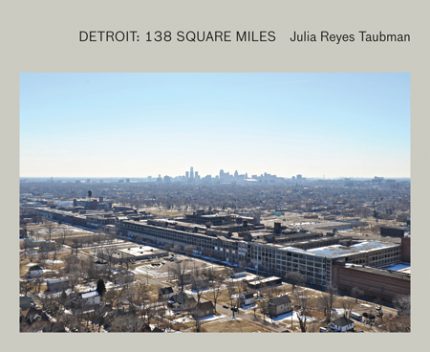
Detroit Disassembled (hardcover)
“My city destroys and annihilates itself from instant to instant,” the poet Giuseppe Ungaretti wrote. He was speaking of his native city of Alexandria, but in a new book of photographs by Andrew Moore, “Detroit Disassembled,” Philip Levine applies the same words to describe contemporary Detroit. In these pictures, the auto-industry capital, a city now one-third empty land, has all the wasted grandeur and crumbling beauty of that ancient metropolis, gorgeous in its decay and disturbing in its implications.
The images are saturated in color, empty of people, composed with a hushed equanimity. Here we see the ruined shell of Michigan Central Station, there a book repository where the books seem to have melted and fused. As Moore himself says, the city is filled with thousands of houses, libraries, factories, apartments, and hospitals “abandoned and mostly unguarded, barely salvageable, and slated for demolition that gets delayed year after year.” The pictures depict a ghost town, reminiscent of Robert Polidori’s images of Chernobyl, where everything was left entirely intact, abandoned in an instant but allowed to rot for decades. The primary signs of life in Moore’s photographs come not from humans, but from nature: mossy grass grows in buildings, trees crawl from warehouses, and houses are swallowed whole by reaching vines. Moore’s postscript—and more quietly but importantly, his photographs—invoke Detroit’s motto, Speramus Meliora, Resurget Cineribus: “We hope for better things; it will arise from the ashes.”
Read more: http://www.newyorker.com/online/blogs/books/2010/03/american-ruins.html#ixzz0kBUIHkhD
No longer the Motor City of boom-time industry, the city of Detroit has fallen into an incredible state of dilapidation since the decline of the American auto industry after the Second World War. Today, whole sections of the city resemble a war zone, its once-spectacular architectural grandeur reduced to vacant ruins. In Detroit Disassembled, photographer Andrew Moore records a territory in which the ordinary flow of time-or the forward march of the assembly line-appears to have been thrown spectacularly into reverse. For Moore, who throughout his career has been drawn to all that contradicts or seems to threaten America’s postwar self-image (his previous projects include portraits of Cuba and Soviet Russia), Detroit’s decline affirms the carnivorousness of our earth, as it seeps into and overruns the buildings of a city that once epitomized humankind’s supposed supremacy. In Detroit Disassembled, Moore locates both dignity and tragedy in the city’s decline, among postapocalyptic landscapes of windowless grand hotels, vast barren factory floors, collapsing churches, offices carpeted in velvety moss and entire blocks reclaimed by prairie grass. Beyond their jawdropping content, Moore’s photographs inevitably raise the uneasy question of the long-term future of a country in which such extreme degradation can exist unchecked. – Publishers Weekly, 136 pps, full color, oversized
$ 50.00



